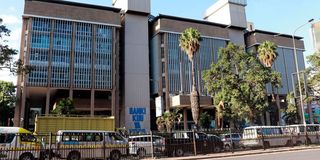Can’t pay public service salaries and other short stories

Central Bank of Kenya headquarters in Nairobi. In the past seven months, Central Bank has increased interest rates four times.
The government is borrowing big time; Sh337 billion in the domestic market since January.
A large portion (Sh191.4 billion, about 57 per cent) has been in treasury bills, because a sceptical market has shied away from bonds, with the performance of a recent bond at a miserable 18 per cent of the intended amount.
Concern about Kenya’s debt is not new. And counties are not yet part of it, as none has issued a bond. The Laikipia bond, which got to the regulatory touchline, is still awaiting action by the Senate and the National Assembly. Why the debt distress and was it anticipated?
A useful starting point is the 2023 Medium Term Debt Management Strategy. Tabled in Parliament on February 15, the government claimed national debt remained sustainable at 60 per cent of gross domestic product (GDP), but that they intend to slow down fiscal deficits (fiscal consolidation), in order to reduce the rate of debt accumulation.
At both levels of government, a debt management strategy is a requirement of the Public Finance Act, thus a normal part of the budgeting process.
Here is what the strategy says. The government planned to borrow one trillion in the 2021/22 fiscal year but borrowed Sh732 billion.
They intended a 27:73 foreign-to-domestic debt mix but ended up with 15:85, a heavier reliance on the domestic market. From an intended Sh343.1 billion in external debt, they borrowed Sh145.5 billion.
Further, no new commercial loan is shown for that year, and the external commercial debt (including Eurobond) is 13 per cent of the total debt.
Oddly, only 5.4 per cent of the external debt is denominated in yuan. I suppose the Chinese have been lending us US dollars.
One false story by politicians and advisers is that they are retiring short-term debt that is maturing this year. False because all T-bills that have matured since January have been rolled over.
Another story that politicians have offered for the crunch is the repayment of high-cost commercial loans, now due. You should ask them to give you specifics because the debt management strategy says differently!
Although some external debt (about Sh200 billion) matures this year, the bulk of this year’s maturities (about Sh800 billion) are domestic and short-term!
Short-term securities
All is not lost. The overall debt maturity profile is improving, with the portion of short-term securities of under one year reducing from 25.9 per cent of total domestic debt in December 2021 to 19.5 per cent in December.
National Treasury and the IMF have been saying Kenya has a high risk of debt distress since 2020, precisely because of the large stock of short-term debt.
The Treasury has been re-profiling the debt — that is replacing short with longer maturity debt — for example, with the switch bond last December. Part of the bond proceeds was applied to retire old debt.
The current total stock of debt is about evenly split between domestic and foreign. But the interest payments on domestic debt are about three times those of external debt on account of very high-interest rates.
In the past seven months, Central Bank has increased interest rates four times. The immediate casualty has been the Treasury itself since each increment has a corresponding effect on the interest rates at the weekly and monthly auctions.
Most investors are now preferring treasury bills, and since there is a crunch, the government is accepting to pay higher rates. For the second week in a row, t-bill rates are above 10 per cent.
Matters have escalated dramatically since January 2. First, the government has rolled over all due bills at higher costs with each successive auction!
Second, the government has been picking up Sh10-20 billion in new short-term debt each week, working out to Sh191.4 billion in the last three-and-a-half months.
So, the government is digging an even deeper, more expensive hole. And they are not paying salaries nor disbursing to counties.
The Central Bank expects inflationary pressure to remain high over the next year because of increases in electricity tariffs, although the moderate long rains will provide some relief, easing the pressure on food prices.
You can, therefore, expect further increases in interest rates.
The promised Sh300 billion budget cuts were, to use the language of the day, “hot air”. The supplementary budget increased expenditure by Sh35.6 billion.
The government expects you to pay Sh2.89 trillion in taxes, and direct fees to ministries for services, this coming budget, and 3.23 trillion the year after.
And all this, while business and consumer confidence has taken a serious knock. Reckless government spending has put Kenya in the middle of debt distress.
@NdirituMuriithi is an economist





